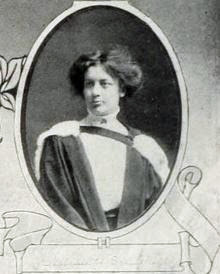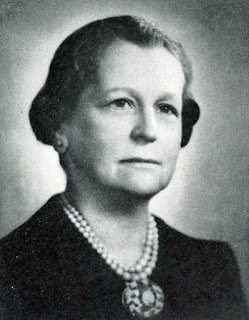Lillian Smith became the first Canadian children’s librarian with
academic credentials when she began her career at Toronto Public Library
in 1912. By the time of her retirement, TPL was providing book services
at Boys and Girls House, 16 library branches, 2 settlement houses, 30
school libraries, and two hospitals. The quality of services at Boys and
Girls House so much impressed Edgar Osborne, a British librarian and
collector, that he donated 1,800 children’s books to TPL in 1949, the
nucleus of today’s outstanding collections at the Lillian H. Smith
branch on College Street. Lillian Smith made valuable contributions to the
American and Ontario library associations in children’s and youth
services and was instrumental in forming the Canadian Association of
Children’s Librarians in 1939.
Lillian Helena Smith
Born March 17, 1887, London, ON; Died January 5, 1983, Toronto, ON
Education:
1910 BA (Victoria University, Toronto)
1910-1912 Diploma (Carnegie Training School for Children’s Librarians, Pittsburgh)
1931 BS in Library Science (Carnegie Library School, Carnegie Institute of Technology, Pittsburgh)
Positions:
1911-1912 Children’s librarian and branch head, New York Public Library
1912-1952 Head of children’s services, Toronto Public Library
Publications:
Smith, Lillian H. (1913). “Boys and girls and the public library.“ Proceedings of the Ontario Library Association Annual Meeting: 67-70.
Smith, Lillian H. (1917). “The children's librarian.” Acta Victoriana 42, 2: 63-65.
Smith, Lillian H. (1917). “A list of books for boys and girls.” Ontario Library Review 2, no.1: 11-33.
Smith, Lillian H. (1923). “The problems of children’s librarians.” Library Journal 48 (no. 17) 1 October.: 805-806.
Smith, Lillian H., ed. (1927). Books for boys and girls. Toronto: Toronto Public Library.
Smith, Lillian H. (1932). “The teaching of children’s literature.” In: American Library Association Children’s Library Yearbook, vol. 4: 73-80.
Smith, Lillian H., ed. (1932). Books for boys and girls, June 1927 to June 1932, a supplement. Toronto: Toronto Public Library.
Smith, Lillian H. (1939).”The library’s responsibility to the child.” In: The library of tomorrow: a symposium, ed. Emily M. Danton. Chicago: American Library Association. p. 124-132.
Smith, Lillian H., ed. (1940). Books for boys and girls. 2nd ed. Toronto: Ryerson Press.
Smith, Lillian H. and Annie Wright (1941). “Canada: a reading guide for children and young people.” Ontario Library Review 25, 1 August: 293-300.
Smith, Lillian H. (1947). “The children’s library.” Journal of the Royal Architectural Institute of Canada 24, 2 February: 56-58.
Smith, Lillian H. (1953). The unreluctant years: a critical approach to children’s literature. Chicago: American Library Association.
Smith, Lillian H. (1959). “What books mean to children.” American Library Association Bulletin 53, 4 April: 289-291.
Smith, Lillian H. (1963). “News from Narnia.” Horn Book Magazine 39, October: 470-473.
Associations/Committees:
1928-1929 President, Ontario Library Association
1932-1936 Member of Executive Board, American Library Association
Honours:
Clarence Day Award, American Library Association, in 1962 for outstanding work in encouraging the love of books and reading.
Toronto Public Library established the Lillian H. Smith Collection in 1962, as a tribute to her years of work at Boys and Girls House.
The Lillian H. Smith branch of Toronto Public Library opened on 16 October 1995 in honour of the first academically trained children’s librarian in the British Empire.
Accomplishments:
“The Unreluctant Years,” published in 1953, distills Smith’s ideas about library book selection and its potential to edify and stimulate children. Her book remains a classic statement for the rationale to apply critical standards of literary value in book selection for young readers and for her insistence on the provision and employment of ‘best books’ by children’s librarians. Smith also edited valuable editions of TPL’s “Books for Boys and Girls.”
Storytelling and programming was another vital aspect of library work that Smith and her devoted staff actively promoted. A ‘Book Week’ for boys and girls became a regular feature before Christmas at TPL well before a national Young Canada Book Week was established in 1949. As well, from the end of WWII to the 1950s, librarians at Boys and Girls House collaborated with the CBC in a series of radio programs for children. Service to non-English speaking children was provided through Toronto settlement houses. Boys and Girls House was always noted for its experimental approaches and offerings of drama, folk dancing, puppet shows, and clubs—features that are often taken for granted in the 21st century library.
Comments:
“Miss Lillian H. Smith long envisioned a nation-wide association for the advancement of children’ s reading in Canada and, at a joint conference of the Ontario and Quebec Library Associations, held in Montreal in the year 1939, she took action to make such an organization a ‘fait accomplil.’” — Ruth Milne, “C.A.C.L. Tribute,” 1952.
“Every parent in Toronto should be grateful to Miss Smith.” — Charles Sanderson, Chief Librarian, Toronto Public Library, 1953.
“She loves and understands children; knows how they think and what interest them. Among her associates, she has had the faculty of inspiring loyalty and transmitting enthusiasm—gifts which do much to explain her success.” — Toronto Globe and Mail editorial, 1952.
Sources:
Lillian H. Smith website developed by Michael Manchester. Accessed December 2022.
Fasick, Adele. M., Margaret Johnston and Ruth Osler, eds. (1990). Lands of pleasure: essays on Lillian H. Smith and the development of children’s libraries. Metuchen, N.J.: Scarecrow Press.
Canadian Association of Children’s Librarians (1952). Lillian H. Smith; a tribute from the C.A.C.L., June 10, 1952. Ottawa: Canadian Library Association.
McGrath, Leslie A. (2005). Service to children in the Toronto Public Library; a case study, 1912-1949. University of Toronto Ph.D. dissertation.
Sydell Waxman (2002). Believing in books: the story of Lillian H. Smith. Toronto: Napoleon Publishing. [biography for children]
Giles, Suzette (2013). “Libraries named after librarians.” ELAN no. 54 (Fall): 7-8.
My biography first appeared in 2015 on the Ex Libris Association website. The graduate portrait is taken from the Torontonensis yearbook of 1910 (p 102).











